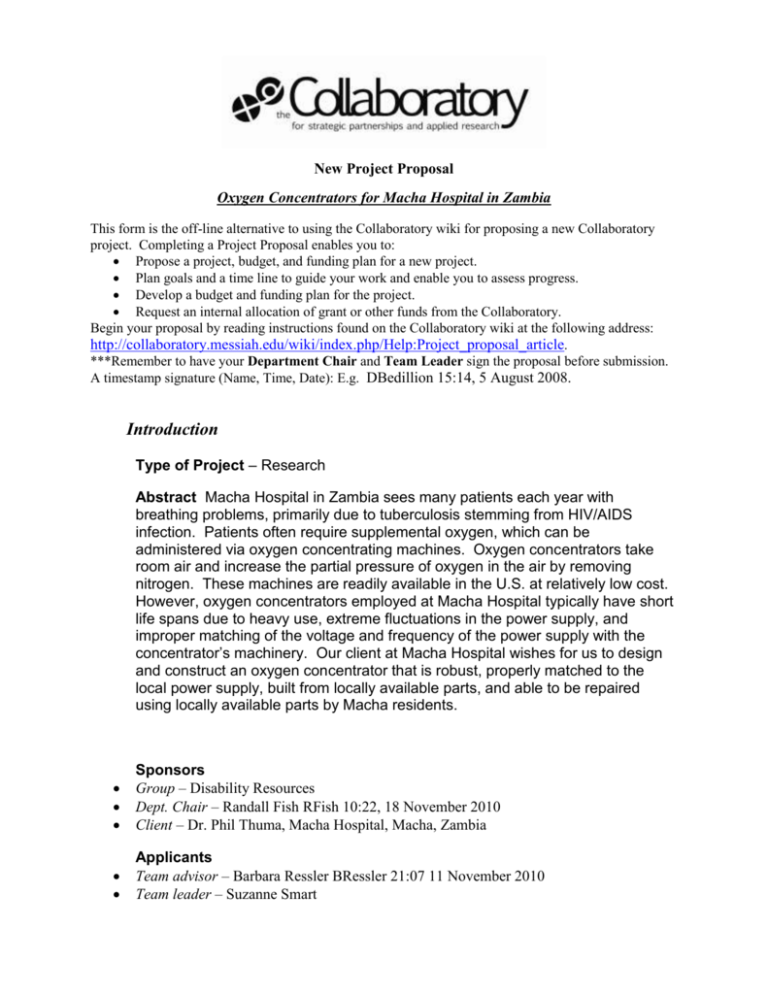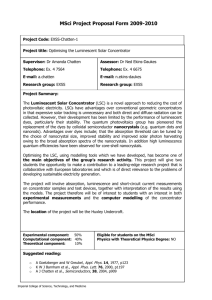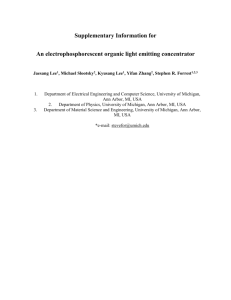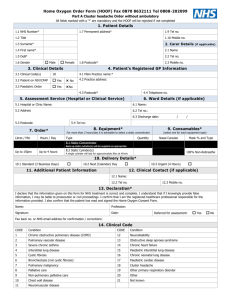Project Proposal
advertisement

New Project Proposal Oxygen Concentrators for Macha Hospital in Zambia This form is the off-line alternative to using the Collaboratory wiki for proposing a new Collaboratory project. Completing a Project Proposal enables you to: Propose a project, budget, and funding plan for a new project. Plan goals and a time line to guide your work and enable you to assess progress. Develop a budget and funding plan for the project. Request an internal allocation of grant or other funds from the Collaboratory. Begin your proposal by reading instructions found on the Collaboratory wiki at the following address: http://collaboratory.messiah.edu/wiki/index.php/Help:Project_proposal_article. ***Remember to have your Department Chair and Team Leader sign the proposal before submission. A timestamp signature (Name, Time, Date): E.g. DBedillion 15:14, 5 August 2008. Introduction Type of Project – Research Abstract Macha Hospital in Zambia sees many patients each year with breathing problems, primarily due to tuberculosis stemming from HIV/AIDS infection. Patients often require supplemental oxygen, which can be administered via oxygen concentrating machines. Oxygen concentrators take room air and increase the partial pressure of oxygen in the air by removing nitrogen. These machines are readily available in the U.S. at relatively low cost. However, oxygen concentrators employed at Macha Hospital typically have short life spans due to heavy use, extreme fluctuations in the power supply, and improper matching of the voltage and frequency of the power supply with the concentrator’s machinery. Our client at Macha Hospital wishes for us to design and construct an oxygen concentrator that is robust, properly matched to the local power supply, built from locally available parts, and able to be repaired using locally available parts by Macha residents. Sponsors Group – Disability Resources Dept. Chair – Randall Fish RFish 10:22, 18 November 2010 Client – Dr. Phil Thuma, Macha Hospital, Macha, Zambia Applicants Team advisor – Barbara Ressler BRessler 21:07 11 November 2010 Team leader – Suzanne Smart Additional advisors – N/A Additional students – Jaime Gerhart, Timothy Houck Narrative Statement of need: Macha Hospital in Zambia treats many patients who require supplemental oxygen. Supplemental oxygen can be easily and safely administered using an oxygen concentrator, which removes nitrogen from room air and returns air enriched with oxygen to the patient. The oxygen concentrators at Macha Hospital tend to fail relatively quickly due to heavy use, large fluctuations in the power supply, and mismatched voltage and frequency between the power supply and the concentrator circuitry. The hospital needs oxygen concentrators that are matched to the voltage and frequency of the power supply, have the ability to withstand large fluctuations in the power supply, are reparable using locally available parts and labor, and that deliver oxygen at the appropriate rate and concentration. State of the art: Oxygen concentrators are readily available in the U.S. at relatively low cost (price range is $500 - $6000 each). New and used concentrators from the U.S. could easily be donated and brought to Macha Hospital, but these machines are not well-suited for use in Zambia, even with the addition of transformers to convert the supply voltage and frequency. Concentrators made in China and purchased in Zambia also do not last much longer than one year. It is not the lack of technology or standards that is the challenge in Zambia, but the robustness of the equipment and the availability of parts for repair that are the difficulties. Related experience: Barbara Ressler traveled to Macha, Zambia June 2010 for an exploratory visit to determine some needs at Macha Hospital that the engineering department could help meet. She also has gone on two other site team visits to Mali for the Water and Disabilities Study. Proposed work: Ultimately we would like to design and construct an oxygen concentrator using parts locally available in Zambia. The concentrator would be produced at the lowest cost possible, come complete with a manual for construction and repair, and be thoroughly tested for quality and correct oxygen delivery. However, building a concentrator “from scratch” may not be an obtainable goal, so the project will proceed in stages that will either lead to complete de novo construction and/or to the modification of already manufactured machines to make them suitable for use in Macha. The first stage of the project will be the research stage. Students will obtain broken portable oxygen concentrators, take them apart, learn and document what each part does, and repair the concentrators. During this stage we will also meet with our client in Zambia to determine more precisely what the hospital’s needs are, the failure modes of the concentrators in Zambia, their source of their current oxygen concentrators, and the local availability of parts. Once the background information is obtained and the students become well versed in oxygen concentrator design and operation, they will construct the first prototype that will likely be a modified used oxygen concentrator. This prototype could be used in Zambia but will not be constructed entirely of locally available parts. It will be tested under conditions likely to be found in Zambia (with the power supply transformed from the U.S. voltage and frequency, and with large fluctuations in power supply). Once we determine the modified concentrator can withstand the Zambian environment and indeed delivers the correct oxygen concentration, then it can be put to use at Macha Hospital. After this point, the project will move on to the application stage, where we will improve upon our designs and do more of the design and construction of the concentrators ourselves. Partnerships: Dr. Phil Thuma is a Messiah College alumnus and a long-term resident of Zambia and of Dillsburg. He is currently the director of Malaria Institute at Macha (MIAM) but plans to step down from his research director role in order to spend more time on his medical practice. Dr. Thuma has worked with Messiah College faculty and students in the past (although not the engineering department) and knows well the mission of the college. Dr. Thuma will be the end user of our product; he will be responsible for giving us feedback on our design and supply us with suggested improvements. Mission fit: This project fits in well with the Disability Resources Group, while introducing Biomedical Engineering to the Collaboratory. It allows students to develop skills in biomedical instrumentation and equipment manufacturing. It also provides valuable cross-cultural trips and work experiences, but without the difficulty of learning another language. The project serves to foster justice and empower the poor by providing a most basic need: a chance at recovery from devastating illness via proper medical treatment. Summary Goals To design and construct oxygen concentrators for use at Macha Hospital which will provide the patients with the supplemental oxygen necessary for optimum medical treatment. Specifications Any modified or newly constructed oxygen concentrators will: 1. Function within WHO specifications for range of % oxygen concentrations and flow rate. 2. Function within specification under power supply conditions found at Macha Hospital for at least one year, with minimal maintenance and repair. 3. Be constructed out of locally available parts, and/or locally reparable parts. 4. Come with a manual detailing the function of each part, plus instructions for testing each part for functionality and for part repair. 5. Be affordable to Macha Hospital (price TBD, but less than the models available in the U.S.). Deliverables 1. A written report, with diagrams, detailing how each part of an oxygen concentrator functions, how to test if the part is working, and suggestions for part repair. 2. A written report, with diagrams, describing the failure mode(s) of oxygen concentrators at Macha Hospital. If the oxygen concentrators are repaired at Macha, the report shall also include the repair procedures and a list of parts and equipment necessary to make these repairs. 3. A complete testing procedure and results for testing any oxygen concentrator for functionality (i.e., oxygen concentration and flow rates over the desired range) and for robustness (i.e., for function within specifications over the expected lifetime of the concentrator). 4. A modified oxygen concentrator (preferably one already at Macha Hospital) that can function within specifications for at least one year with basic maintenance and repairs required. 5. A newly constructed oxygen concentrator made only of locally available and/or locally reparable parts that functions within specifications for at least one year at Macha Hospital. Time Line Academic year 2010/2011 1. Obtain broken oxygen concentrators. Disassemble them, document parts and part function, and deliver report December 2010. 2. Apply for site team visit, November 15, 2010. 3. Meet with client November 18, 2010. Determine site team trip feasibility and goals with client. Discuss concentrator specifications with client to make sure they meet with his approval. 4. Repair broken oxygen concentrators and return to normal function. Repaired concentrations must deliver air flow rates and oxygen concentrations as specified by the WHO or FDA. Deadline: April 2011. 5. Site team visit: May/June 2011. Determine failure modes of concentrators at Macha, make necessary repairs to restore them to function, and test for proper function. Research availability of concentrator parts. Academic Year 2011/2012 1. Take an existing concentrator and make any changes needed to make it function within specifications under conditions at Macha Hospital. Also construct or purchase a device that will deliver power under the conditions found in Macha. Deadline: December 2011. 2. Test the modified oxygen concentrator under the appropriate conditions to determine the expected lifetime of operation under Zambian conditions. Deadline: April 2012. 3. Write a repair and maintenance manual for modified concentrators for use in Macha. Deadline: April 2012. 4. Site team visit: May/June 2012. Make the same changes to one or more concentrators at Macha and perform abbreviated performance tests. Arrange for status reports on concentrator functions over the next year. Train hospital workers in concentrator maintenance and repair using the manual from step 3. Academic Years 2012/2013 and 2013/2014 1. If necessary, re-design and test modified oxygen concentrators. 2. Begin construction of a de novo oxygen concentrator. Purchase necessary parts that are also locally available and/or deliverable in/to Zambia. Construct custom parts such as concentrator casing. Deadline: December 2012. 3. Test new concentrator for functionality and robustness under Zambian conditions. Deadline: April 2013. 4. Re-design, modify, and test new oxygen concentrator for functionality and robustness under Zambian conditions. Prepare concentrator for use at Macha. Write construction and operation manual. Deadline: April 2014. 5. Site team visit: May/June 2014. Deliver new oxygen concentrator to Macha. Test for functionality and arrange for status reports throughout the upcoming year. Train hospital workers in concentrator use, maintenance, and repair. Resources 1. 2. 3. 4. 5. 6. Personnel and facilities Academic Disciplines required: Biomedical Engineering, Mechanical Engineering, and Electrical Engineering concentrations. Skills: use of machine shop tools (shop certification), circuit and microprocessor analysis, oxygen and flow rate sensor operation and design. SSEH Disciplines: (Bio)Instrumentation and Measurement, circuits, fluid mechanics, physiology, BME Design. Number of students required: 2 – 3 per year are sufficient. Space: We have a small space in the Lego lab, plus storage for concentrators. This is sufficient for our needs. Equipment: machine shop tools, oxygen concentration measurement machine provided by Health & Human Performance department, flow meters, DDM for circuits testing. 7. Safety issues: none other than usual machine shop safety requirements. Redundant oxygen concentrators should be available in Macha, in case of machine failure. Also, no smoking around the machines. Budget Please read instructions and download a budget work sheet from the Collaboratory wiki: http://www.thecollaboratoryonline.org/wiki/Help:Project_budget_worksheet. Forward a completed budget worksheet along with this proposal to the Student Director at Collaboratory@messiah.edu.







